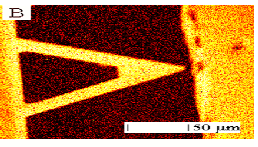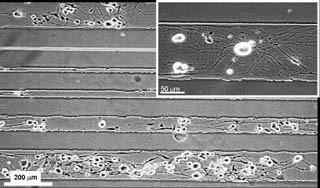Background & Goals of Project
 Diseased and damaged adult central nervous system (CNS) tissue displays a limited capacity for repairing itself. Although limited functional recovery may be achieved by sprouting and other compensatory mechanisms, wholesale regeneration to promote substantial recovery has not be observed. Over the past two decades, numerous studies in animals and man strongly suggest that restorative therapies based on cell transplantation are feasible. A major challenge remains in determining how to reconstruct neural pathways: how to produce function-restoring outgrowth at specific targets.
Diseased and damaged adult central nervous system (CNS) tissue displays a limited capacity for repairing itself. Although limited functional recovery may be achieved by sprouting and other compensatory mechanisms, wholesale regeneration to promote substantial recovery has not be observed. Over the past two decades, numerous studies in animals and man strongly suggest that restorative therapies based on cell transplantation are feasible. A major challenge remains in determining how to reconstruct neural pathways: how to produce function-restoring outgrowth at specific targets.
 Biomaterials have been examined as "bridging" devices to support directed nerve outgrowth. On of the fundamental challenges involves understanding how to design the surface of such biomaterial bridges, which may in some cases be coated with a cellular layer that supports neuronal survival and directed outgrowth.
Biomaterials have been examined as "bridging" devices to support directed nerve outgrowth. On of the fundamental challenges involves understanding how to design the surface of such biomaterial bridges, which may in some cases be coated with a cellular layer that supports neuronal survival and directed outgrowth.
We are currently interested in development of new biomaterials that can be implanted, injected or otherwise delivered to sites of damage or injury in the central nervous system for the restoration of lost function through the regrowth of damaged neurons.
The Neuron Pathfinding project has several distinct sub-categories:
Ligand-Receptor Force Measurements
 We are interested in studying the effects of well controlled and characterized biomaterials surfaces (contact angle, XPS, TOF-SIMS) on nerve regeneration, using single-molecule techniques, including the direct measurement of ligand-receptor forces by Atomic Force Microscopy (AFM). We developed the Poisson AFM Analysis Method that uses chemically or biologically functional AFM tips to measure individulal molecule-molecule and ligand-receptor rupture forces.
We are interested in studying the effects of well controlled and characterized biomaterials surfaces (contact angle, XPS, TOF-SIMS) on nerve regeneration, using single-molecule techniques, including the direct measurement of ligand-receptor forces by Atomic Force Microscopy (AFM). We developed the Poisson AFM Analysis Method that uses chemically or biologically functional AFM tips to measure individulal molecule-molecule and ligand-receptor rupture forces.
Protein Surface Chemistry
We are optimizing several different methods of surface modification to both stimulate and suppress neuron outgrowth. The methods involve covalent attachment chemistries for extracellular matrix proteins and relevant protein-derived peptides.

Patterning and Gradient Surfaces
We are interested in creating well characterized substrates, using contact angle measurements, XPS, TOF-SIMS and AFM, with controlled surface density of extracellular matrix proteins (e.g. laminin and fibronectin), and extracellular matrix-derived ligands (e.g. SIKVAV- and RGD-containing peptides). To prevent protein adsorption and cell attachment, we are creating patterned comb-polymer surfaces using micro-contact printing (uCP) techniques.
 Figure 1: TOF-SIMS images of comb polymer-fibronectin patterened surfaces used for directing neuron outgrowth.
Figure 1: TOF-SIMS images of comb polymer-fibronectin patterened surfaces used for directing neuron outgrowth.
 Figure 2: Neurons attachment on Fibronectin/comb polymer substrates with increasing patteren widths.
Figure 2: Neurons attachment on Fibronectin/comb polymer substrates with increasing patteren widths.
Skills You Will Develop on this Project
Students and postdocs involved in this project will be exposed to surface instrumental analysis techniques, especially XPS and TOF-SIMS, the development of new surface chemistries and the quantitative analysis thereof, the use of STM and AFM, the use of standard cell-culture methodology, and the use of high-resolution optical fluorescence microscopy.
Examples of Publications from the Group
Zhang, Zhanping; Yoo, Raphael; Wells, Matthew; Beebe, Thomas P., Jr.; Biran, Roy; Tresco, Patrick. Neurite outgrowth on well-characterized surfaces: preparation and characterization of chemically and spatially controlled fibronectin and RGD substrates with good bioactivity. Biomaterials (2004), Volume Date 2005, 26(1), 47-61.
Hyun, Jinho; Ma, Hongwei; Zhang, Zhanping; Beebe, Thomas P., Jr.; Chilkoti, Ashutosh. Universal route to cell micropatterning using an amphiphilic comb polymer. Advanced Materials ( Weinheim, Germany) (2003), 15(7-8), 576-579.
Y. S. Lo, J. Simons and T.P. Beebe, Jr., "Temperature Dependence of the Biotin-Avidin Bond-Rupture Force Studied by Atomic Force Microscopy, "Journal of Physical Chemistry, B 106(38) (2002) 9847-9852.
Y.-S. Lo and T.P. Beebe, Jr., "Loading-Rate Dependence of Individual Ligand-Receptor Bond-Rupture Forces Studied by Atomic Force Microscopy,"Langmuir, 17(12) (2001) 3741-3748.